GIGABYTE BRIX Pro: A First Look at the Intel i7-4770R with Iris Pro HD 5200
by Ganesh T S on January 7, 2014 8:00 PM EST
Gigabyte is targeting the BRIX Pro towards professional consumers with compute-intensive workloads. For general office use (including web browsing and light word processing work), systems such as the Core i5-based NUC we reviewed last week are more than enough. In order to bring out scenarios where the extra grunt provided by the Pro unit becomes necessary, we are presenting some real world benchmarks below. These are tasks carried out by workers where time in money, and the premium paid upfront for the better configuration is trivial compared to the time saved.
WinRAR Benchmark
We present two benchmarks using WinRAR. The first one involves decompressing a 4.36 GB split archive and recording the time taken to complete the process. This is a test of the CPU power as well as the storage subsystem.
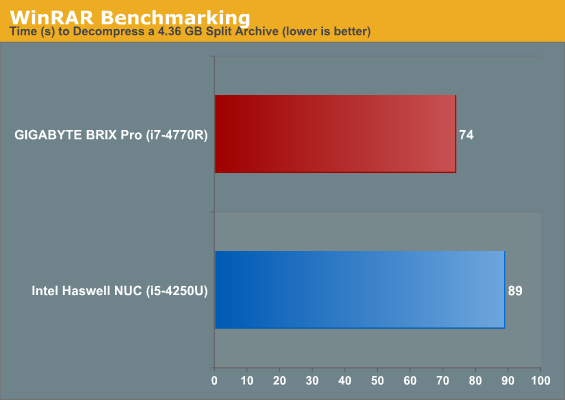
The graph below presents the internal WinRAR benchmark numbers. In this benchmark, the program takes compresses / decompresses random data in the RAM. This is a test of the CPU power as well as the DRAM capabilities.
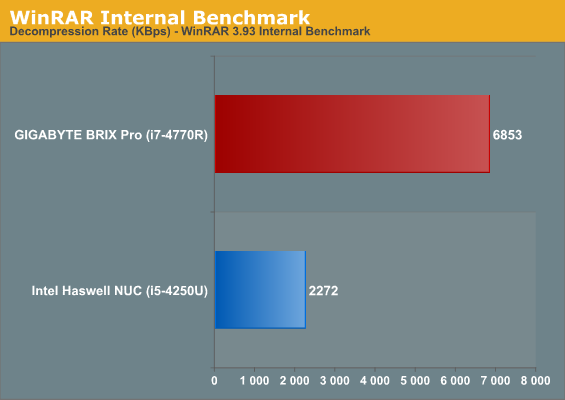
TrueCrypt Benchmark
As businesses (and even home consumers) become more security conscious, the importance of encryption can't be overstated. CPUs supporting the AES-NI instruction for accelerating the encryption and decryption processes have, till now, been the higher end SKUs. However, with Bay Trail, even the lowly Atom series has gained support for AES-NI. Both the i5-4250U and the i7-4770R have AES-NI instructions support. The TrueCrypt internal benchmark provides some interesting cryptography-related numbers to ponder. In the graph below, we can get an idea of how fast a TrueCrypt volume would behave in the two different systems.
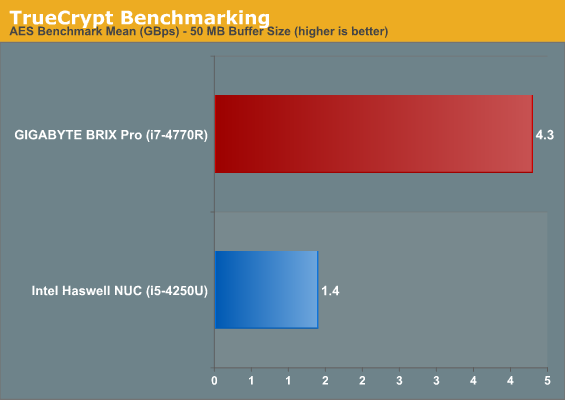
Agisoft PhotoScan
Agisoft PhotoScan is a commercial program that converts 2D images into 3D point maps, meshes and textures. The program designers sent us a command line version in order to evaluate the efficiency of various systems that go under our review scanner. The command line version has two benchmark modes, one using the CPU and the other using both the CPU and GPU (via OpenCL). The benchmark takes around 50 photographs and does four stages of computation:
Stage 1: Align Photographs
Stage 2: Build Point Cloud (capable of OpenCL acceleration)
Stage 3: Build Mesh
Stage 4: Build Textures
We record the time taken for each stage. Since various elements of the software are single threaded, others multithreaded, and some use GPUs, it is interesting to record the effects of CPU generations, speeds, number of cores, DRAM parameters and the GPU using this software.
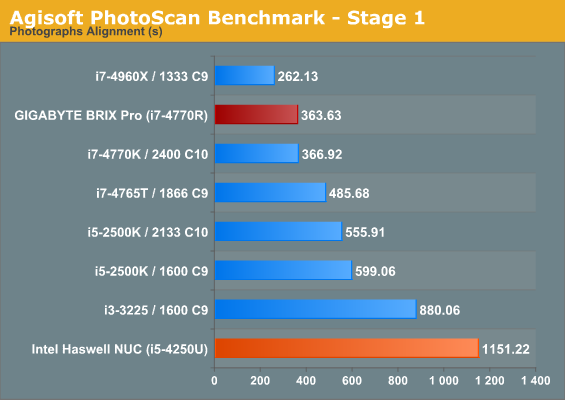
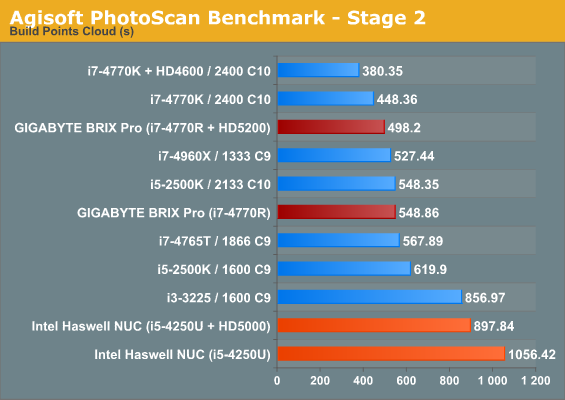

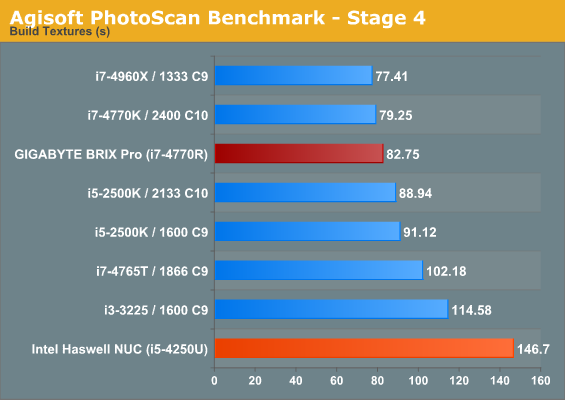
The second stage also reports the throughput rate of the CPU and GPU in million points per second. For the BRIX Pro, in the CPU only mode, we had a rate of 124.99 mp/s. Using OpenCL acceleration, the CPU and GPU had rates of 69.5 mp/s and 98.32 mp/s respectively. The corresponding numbers for the NUC were 68.36 mp/s, 20.39 mp/s and 78.59 mp/s.
Essentially a prosumer real-world test, we hope to put more of our systems under this benchmark in the future. Ian already has a large number of custom-built systems for which he will present benchmarks in his motherboard reviews.










98 Comments
View All Comments
elian123 - Thursday, January 9, 2014 - link
I wonder whether 3200x2000 may be the max resolution with single stream transport and that multi stream transport does allow for 4K?Gadgety - Wednesday, January 8, 2014 - link
So I'm expecting to see a Kaveri APU equivalent available for less.zodiacfml - Wednesday, January 8, 2014 - link
Wow, one powerful machine. I did not consider NUC kits before, until this one.It's inevitable to see a kit with the heatsink as part of the case which should give better performance or fanless designs.
theuglyman0war - Sunday, February 2, 2014 - link
vesa mounted behind a center monitor the mount/heatsink design dpesn't care how noisey the stock fan is/was! Time to dust off the dremel...philipma1957 - Wednesday, January 8, 2014 - link
So it is loud and overheats when maxed. I fail to see the value to a home owner. Business it looks pretty good as many stores have a high sound level. It is pricey. 650 + 200 + 100 + 100 = 1050I put 200 for the msata 100 for 8gb ram and 100 for a windows 7 / 8 os.
I use pc's and macs for a home owner's ht the quad core mac mini may be a better deal. I still like the idea of a small system pushing limits. Maybe in 3 more generations it will be a lot nicer for home owners vs businesses .
DryAir - Wednesday, January 8, 2014 - link
The i5-4570R costs only $8 more than the i5-4200U (acording to ARK Intel), but the i5-4570R brix is $140 more expensive than the i5-4200U brix. Why? More plastic? The extra money did not went in the cooling solution, judgind by this results.Ayway, i think that form factor is the better than the ULV one. Still tiny but with a much better processor and 2.5" HDD option.
philipma1957 - Wednesday, January 8, 2014 - link
well that is business , you pay more because it is faster and you need the speed. they gouge you because the extra power is worth it to you. I do agree that the small size is nice but I rather it be a little bigger with better cooling. Plus 650 stripped naked is not cheap. The quad mac mini is 679 from apples refurbished store and come with an os 4gb ram and a 1tb hdd. the prcoessor it not far behind the cpu in here.Wall Street - Monday, January 13, 2014 - link
It went into the extra 128 MB of cache needed for the graphics, there literally is an additional chip in there for this. If you don't want 'gamer' graphics than don't get the Iris Pro. You are paying for in game FPS, with little benefit from the cache in other uses. If this isn't your use, don't get the Iris Pro, the HD 5000 model for a lot less. Of course this one is louder too because Iris Pro is 35 W instead of the 15 watts for the other models. If you don't need Iris pro, then get the smaller quiet model and don't pay for it. Of course, while Iris Pro is loud during games, the low end NUC computers will be < 20 FPS in a lot of games where Iris Pro is ~40 FPS, so the noise definitely gets you something.tabkron - Wednesday, January 8, 2014 - link
Please test Linux on this. Maybe SteamOS, Ubuntu or anything that's using a fairly recent kernel and graphics software.Galatian - Thursday, January 9, 2014 - link
I wish there would be cases with room for at least a slim line ODD. I mean those things are supposed to be used as HTPCs. For me they completely miss their point by trying to be as small as possible.